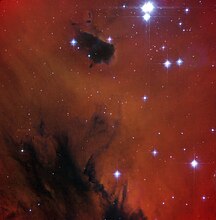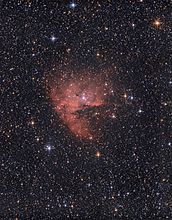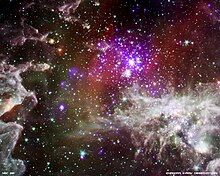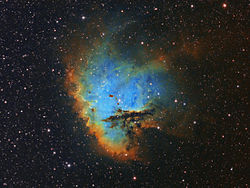NGC 281
| NGC 281 | |
|---|---|
 NGC 281 - úzkopásmový amatérský snímek v Hubbleově paletě | |
| Pozorovací údaje (Ekvinokcium J2000,0) | |
| Typ | emisní mlhovina |
| Objevitel | Edward Emerson Barnard |
| Datum objevu | 16. listopadu 1881 |
| Rektascenze | 0h 52m 25,1s[1] |
| Deklinace | +56°33′54″[1] |
| Souhvězdí | Kasiopeja (lat. Cas) |
| Zdánlivá magnituda (V) | 7,4[2] |
| Úhlová velikost | 35'[3] |
| Vzdálenost | 9 500 ly |
| Označení v katalozích | |
| New General Catalogue | NGC 281 a NGC 281W |
| IRAS | IRAS 00494+5617 |
| Sharplessův katalog | SH 2-184 |
| Katalog Lyndsové | LBN 123.17-06.28 a LBN 616 |
| Jiná označení | NGC 281, Sh2-184, OCl 313,[1] IC 11, Pacman Nebula[4] |
| (V) – měření provedena ve viditelném světle | |
| Některá data mohou pocházet z datové položky. | |
NGC 281 (také IC 11 nebo Sh2-184 ) je jasná emisní mlhovina a součást HII oblasti v souhvězdí Kasiopeji. Je vzdálena přibližně 9 500 světelných let od Země, takže patří do ramena Persea Mléčné dráhy. Objevil ji Edward Emerson Barnard 16. listopadu 1881.
Vlastnosti
Součástí této mlhoviny o rozměrech 20'×30' je také otevřená hvězdokupa IC 1590, několik Bokových globulí a hvězdný systém B 1. Tyto objekty dohromady tvoří jeden systém nazvaný Sh2-184,[1] který má zdánlivý rozměr 40'.[5] Měřením paralaxy vodních maserů na frekvenci 22 GHz, které bylo provedené v roce 2014, byl získán nový odhad vzdálenosti mlhoviny od Země. Naměřená vzdálenost 2,82 ± 0,20 kpc (9 200 světelných let)[6] je mírně nižší než obecně uváděná vzdálenost 9 500 světelných let. Díky svému tvaru, který připomíná postavu z počítačové hry, je mlhovina mezi astronomy známa také pod názvem Pacman Nebula (mlhovina Pacman).
Historie pozorování
Edward Emerson Barnard tuto mlhovinu objevil 16. listopadu 1881 a popsal ji jako "velkou slabou a velmi rozptýlenou mlhovinu." Sherburne Wesley Burnham později v mlhovině objevil vícenásobnou hvězdu 'B 1' (β 1), jejíž hlavní člen HD 5005 (HIP 4121) je velmi zářivou hvězdou osmé magnitudy a spektrální třídy O6 a čtyři společníci jsou od ní vzdáleni 1,4' až 15,7'. Od doby jejich prvního proměření v roce 1875 v tomto pětinásobném systému nenastaly žádné patrné změny.
Poloha IC 11
V místě, které Barnard zaznamenal jako souřadnice objektu IC 11, se mlhovina nenachází, proto některé katalogy považují IC 11 za nenalezený objekt.[7] Trojhvězda zmíněná v popisu však naznačuje, že se Barnard při zápisu polohy zmýlil o 30 minut v rektascenzi. NGC 281 i IC 11 je tedy dvojí označení stejného objektu.[8]
Pozorování
Mlhovinu je možné vidět amatérským dalekohledem z oblastí s tmavou oblohou. Walter Scott Houston ve své knize Deep Sky Wonders popsal vzhled mlhoviny v malém dalekohledu: "V nejbližším okolí vícenásobné hvězdy byla vidět slabá záře a občas jsem měl dojem, že je tam i mnohem větší mlhovina. Její plošná jasnost byla mnohem menší než u Galaxie v Trojúhelníku nebo NGC 205, vzdáleného společníka Galaxie v Andromedě."[9]
Galerie obrázků
NGC 281 – Amatérský úzkopásmový snímek (SII = červená, H-alfa = zelená, OIII = modrá)
Reference
V tomto článku byl použit překlad textu z článku NGC 281 na anglické Wikipedii.
- ↑ a b c d SIMBAD Astronomical Database: Results for NGC 281 [online]. [cit. 2017-03-27]. Dostupné online. (anglicky)
- ↑ Open Clusters. Dostupné online. [cit. 2017-03-24]
- ↑ SEDS.org NGC 281 [online]. [cit. 2017-03-27]. Dostupné online. (anglicky)
- ↑ SLOTEGRAAF, Auke. Deep Sky Observer's Companion: NGC 281 [online]. [cit. 2017-03-27]. Dostupné online. (anglicky)
- ↑ SHARPLESS, Stewart. A Catalogue of H II Regions. S. 257–279. Astrophysical Journal Supplement [online]. Prosinec 1959 [cit. 2017-03-28]. Roč. 4, s. 257–279. Dostupné online. DOI:10.1086/190049. Bibcode:1959ApJS....4..257S. (anglicky)
- ↑ CHOI, Y.K., et al. Trigonometric Parallaxes of Star Forming Regions in the Perseus Spiral Arm. S. 99. Astrophysical Journal [online]. Srpen 2014 [cit. 2017-03-29]. Roč. 790, čís. 2, s. 99. Dostupné online. arXiv:1407.1609. DOI:10.1088/0004-637X/790/2/99. Bibcode:1959ApJ...790...99C. (anglicky)
- ↑ SEDS.org IC 11 [online]. [cit. 2017-04-05]. Dostupné online. (anglicky)
- ↑ SLOTEGRAAF, Auke. Deep Sky Observer's Companion: IC 11 [online]. [cit. 2017-04-05]. Dostupné online. (anglicky)
- ↑ HOUSTON, Walter Scott. Deep-Sky Wonders. [s.l.]: Sky Publishing Corporation, 2005. ISBN 1-931559-23-6.
Externí odkazy
 Obrázky, zvuky či videa k tématu NGC 281 na Wikimedia Commons
Obrázky, zvuky či videa k tématu NGC 281 na Wikimedia Commons - APOD (2005-08-23) NGC 281: The Pacman Nebula
- APOD (2016-11-04) Portrait of NGC 281
- Simbad – NGC 281
Média použitá na této stránce
This composite image of NGC 281 contains X-ray data from Chandra, in purple, with infrared observations from Spitzer, in red, green, blue. NGC 281 is typically divided into two subregions: the region in the upper middle of the image, which is surrounded by the purple 10-million-degree gas, and a younger region in the lower part of the image. There is evidence that the formation of a cluster, appearing in a beige cloud to the lower right, was triggered by a previous generation of star formation. Also, astronomers have found some isolated star formation on the left side of the image that appears to have been occurring at the same time as star formation in other regions of the cluster. This supports the idea that something externally triggered the "baby boom" of stars in NGC 281.
Autor: Stub Mandrel, Licence: CC BY-SA 4.0
NGC281, popularly the 'Pacman Nebula', imaged using a Skywatcher 130P-DS and astro-modded Canon 450D DSLR on an EQ3 mount in a suburban location.
Astronomers have used the NASA/ESA Hubble Space Telescope to study the young open star cluster IC 1590, which is found within the star formation region NGC 281 — nicknamed the Pacman Nebula due to its resemblance to the famous arcade game character. This image only shows the central part of the nebula, where the brightest stars at the core of the cluster are found, with part of the Pacman’s hungry mouth visible as the dark region below.
But Pacman isn’t gobbling up these stars. Instead, the nebula’s gas and dust are being used as raw ingredients to make new stars. However, the stars in IC 1590 are still plotting their escape from the Pacman Nebula, as open clusters are only loosely bound together and the grouping will eventually disperse within a few tens of millions of years.
IC 1590 lies about ten thousand light-years from Earth in the constellation of Cassiopeia (The Queen). Through small telescopes the core of the cluster that appears at the top of this picture shows up as a triple star, but the nebula that surrounds it is much fainter and very hard to see. The eagle-eyed American astronomer E. E. Barnard, using a 15 cm telescope, first recorded it in the late nineteenth century.
This picture was created from images taken using the Wide Field Channel of Hubble’s Advanced Camera for Surveys. Images though yellow (F550M, coloured blue), orange (F660N, coloured green) and red (F658N) filters were combined. The F658N filter isolates light from glowing hydrogen gas. The total exposure times per filter were 450 s, 1017 s and 678 s, respectively and the field of view is about 3.3 arcminutes across.Autor: Hewholooks, Licence: CC BY-SA 3.0
NGC281 - Pacman Nebula in Hubble Palette Narrowband from amateur equipment







